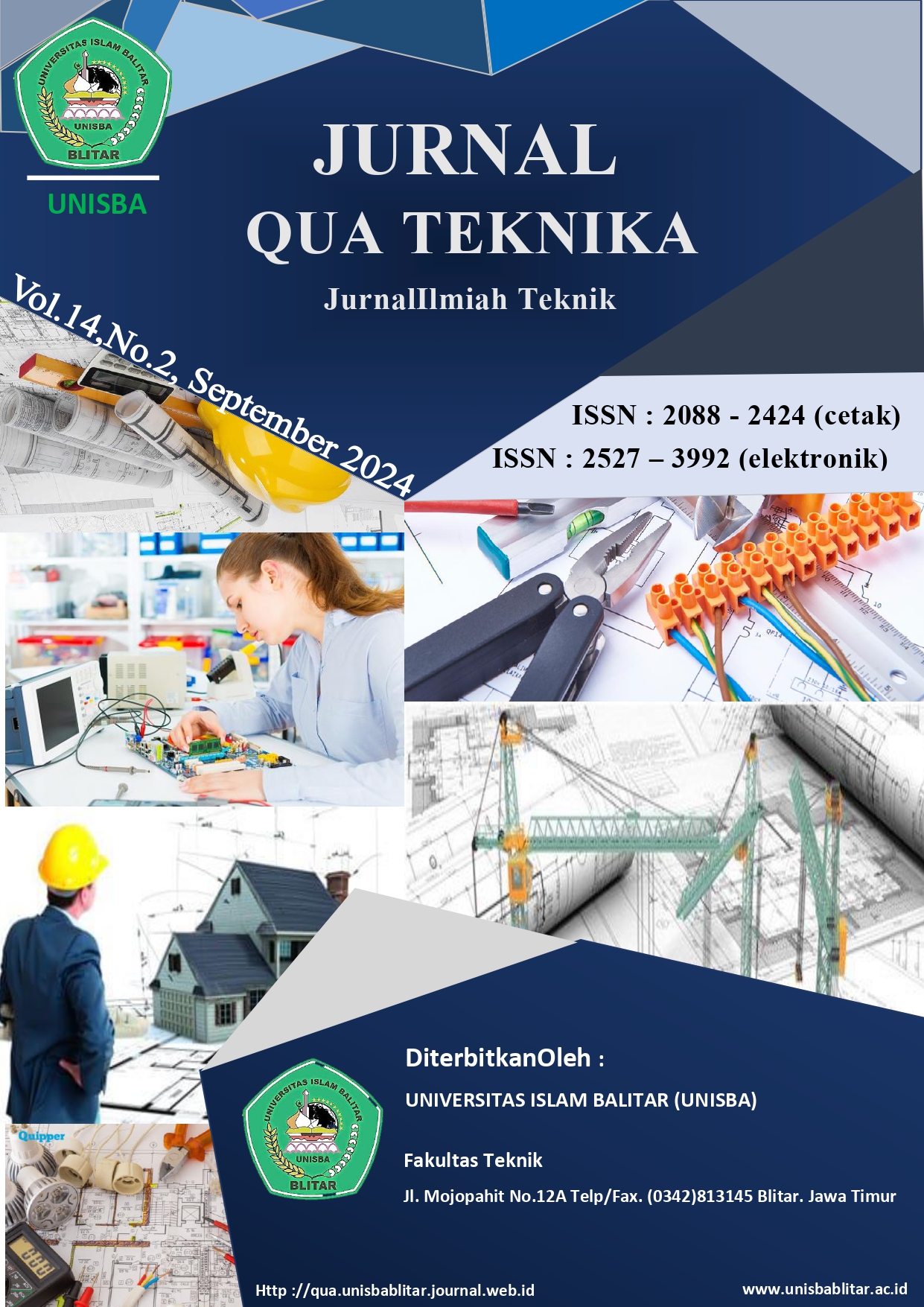ANALISIS PENAMBAHAN PENAMBAHAN CACAHAN LIMBAH MASKER MEDIS PADA KINERJA CAMPURAN ASPAL
DOI:
https://doi.org/10.35457/quateknika.v14i02.3934Keywords:
Infrastructure, Roads, Asphalt, Mask Waste, Asphalt PerformanceAbstract
Roads are a very important matter in the field of construction, Indonesia as a developing country that will enter into a developed country is trying to meet construction needs. Innovations related to the development of good road construction need to be implemented, so that road construction in Indonesia can run well and have results that are in accordance with the standards set in the Indonesian National Standard.
In the previous research using medical mask waste, the selected part was using the inside of the mask, namely polypropylene, the results obtained were satisfactory, but it was less effective in the field directly because the mask had to be sorted inside and outside, so that for further research it was made directly. the shredded mask waste is intact, so that the manufacturing process can be carried out directly without requiring time to sort out the existing waste.
The inside of a medical mask contains several polymers that are difficult to decompose, so there is a risk of contaminating the environment. Moreover, the need for masks during a pandemic is very much, and even now there is no specific way to use them optimally and safely. It is hoped that the use of medical mask waste as an asphalt mixture will increase the stability of the asphalt in the event of cracks due to the large load on the road.
The results of the research showed that the effect of adding mask waste was that there was the greatest increase in stability in the 5% mixture, and gradually decreased in the 10%, 15% and 20% mixture. Compared to the normal mixture (0%) the stability value increased by 70% in the 5% mask mixture. The effect of adding a mask mixture makes the flow value smaller, so that the asphalt has insufficient flexibility. The MQ or Marshall Quotient value is largest in the 15% mixture. A mixture of 10%, 15%, 20% does not meet the VIM values determined in the 2018 general construction specifications.
Kata kunci: Infrastructure, Roads, Asphalt, Mask Waste, Asphalt Performance
References
[2] E. Yalcin, A. Munir Ozdemir, B. Vural Kok, M. Yilmaz, and B. Yilmaz, “Influence of pandemic waste face mask on rheological, physical and chemical properties of bitumen,” Constr. Build. Mater., vol. 337, no. February, p. 127576, 2022, doi: 10.1016/j.conbuildmat.2022.127576.
[3] P. C. Ojha, S. S. Satpathy, A. K. Ojha, L. B. Sukla, and D. Pradhan, “Overcoming challenges due to enhanced biomedical waste generation during COVID-19 pandemic,” Sci. Total Environ., vol. 832, no. January, 2022, doi: 10.1016/j.scitotenv.2022.155072.
[4] M. Saberian, J. Li, S. Kilmartin-Lynch, and M. Boroujeni, “Repurposing of COVID-19 single-use face masks for pavements base/subbase,” Sci. Total Environ., vol. 769, p. 145527, 2021, doi: 10.1016/j.scitotenv.2021.145527.
[5] G. Wang et al., “Use of COVID-19 single-use face masks to improve the rutting resistance of asphalt pavement,” Sci. Total Environ., vol. 826, p. 154118, 2022, doi: 10.1016/j.scitotenv.2022.154118.
[6] D. Zhang, Y. Guo, Z. Liu, P. Xu, Z. Ma, and J. Zhan, “Laboratory investigation on added-value application of the COVID-19 disposable mask in hot mix asphalt (HMA),” Sci. Total Environ., vol. 860, no. November 2022, p. 160243, 2023, doi: 10.1016/j.scitotenv.2022.160243.
[7] A. Susilowati, E. Wiyono, and P. Pratikto, “Pemanfaatan Limbah Plastik Sebagai Bahan Tambah Pada Beton Aspal Campuran Panas,” Bangun Rekaprima, vol. 7, no. 2, pp. 15–21, 2021.
[8] I. N. A. Thanaya, I. G. R. Puranto, and I. N. S. Nugraha, “Studi Karakteristik Campuran Aspal Beton Lapis Aus (AC-WC) Menggunakan Aspal Penetrasi 60/70 dengan Penambahan Lateks,” Media Komun. Tek. Sipil, vol. 22, no. 2, p. 77, 2016, doi: 10.14710/mkts.v22i2.12875.
[9] Diretorate General of Highways, “Spesifikasi Umum Bina Marga 2018 Untuk Pekerjaan Konstruksi Jalan dan Jembatan (Revisi 2),” Minist. Public Work. Hous., no. Oktober, p. 1036, 2020. 500
600
700
800
900
1000
1100
1200
1300
1400
1500
0,00 5,00 10,00 15,00 20,00
Marshall Quotient (kg/mm)
Kadar DMM ( % )
Gambar 6. Grafik Hubungan Antara Kadar DMM
dengan Nilai MQ
Downloads
Published
Issue
Section
License
Authors who publish with this journal agree to the following terms:
- Copyright on any article is retained by the author(s).
- Author grant the journal, right of first publication with the work simultaneously licensed under a Creative Commons Attribution License that allows others to share the work with an acknowledgement of the work’s authorship and initial publication in this journal.
- Authors are able to enter into separate, additional contractual arrangements for the non-exclusive distribution of the journal’s published version of the work (e.g., post it to an institutional repository or publish it in a book), with an acknowledgement of its initial publication in this journal.
- Authors are permitted and encouraged to post their work online (e.g., in institutional repositories or on their website) prior to and during the submission process, as it can lead to productive exchanges, as well as earlier and greater citation of published work.
- The article and any associated published material is distributed under the Creative Commons Attribution-ShareAlike 4.0 International License
Deprecated: json_decode(): Passing null to parameter #1 ($json) of type string is deprecated in /home/ejournal.unisbablitar.ac.id/public_html/plugins/generic/citations/CitationsPlugin.php on line 68










